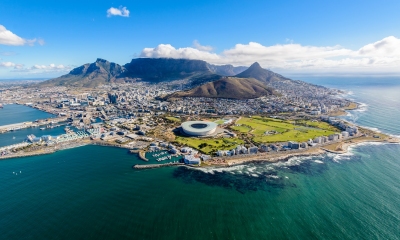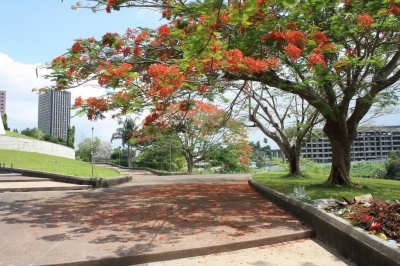![We are the wanderers (A_Peach) [flickr.com] CC BY
License Information available under 'Proof of Image Sources' We are the wanderers (A_Peach) [flickr.com] CC BY
License Information available under 'Proof of Image Sources'](/wp-content/uploads/reiseziele/we-are-the-wanderers49994.jpg)
Furthermore, we analyzed all climate data and provide a recommendation about which months are best to visit Serengeti for your holiday.
Climate Overview
 14 °C to 29 °C
14 °C to 29 °C 0.51 – 5.47 in (3 – 14 Days of Rain)
0.51 – 5.47 in (3 – 14 Days of Rain)Show temperatures in degree
General & Geography
Table of Contents
The Serengeti is an animal-rich savannah area in northern Tanzania and is usually described by experts in the same breath as the Okavango Delta as the best safari area in Africa.
Covering an area of more than 19000 square miles, the reserve extends to the south of Kenya, where it merges directly into the Masai Mara in a common ecosystem.
The vast, almost treeless steppe became well known to a broad public, not least through the German naturalist Professor Dr. Grzimek and his documentary “Serengeti must not die”.
The seemingly endless grassy plains are the scene of one of the greatest natural spectacles on earth when up to two million wildebeests and more than 250,000 zebras and gazelles migrate every year.
This Great Migration in search of nutrient-rich grasslands culminates between December and February with the mass births of young animals mostly in the southern corridor of the Serengeti. A true feast for countless lions, leopards, cheetahs and many other predators!
The Serengeti ecosystem, which offers unforgettable wildlife encounters all year round, includes smaller protected areas such as Mazwa, Grumeti and Ikorongo as well as the neighbouring Ngorongoro Conservation Area.
The world-famous Ngorongoro Crater is part of the Serengeti National Park and is home to the highest predator density on the African continent. According to the latest census, around 3000 lions can be found throughout the Serengeti.
Most safaris along the Northern Circuit in Tanzania start in the city of Arusha, which can be reached via Kilimanjaro International Airport (JRO) via European hubs such as Amsterdam, Paris or Frankfurt.
Climate in the Serengeti
![Safari in The Maasai Mara (Ray in Manila) [flickr.com] CC BY
License Information available under 'Proof of Image Sources'](/wp-content/uploads/reiseziele/safari-in-the-maasai-mara76868_preview.jpg) In the Serengeti a tropical climate prevails, there are only slight temperature fluctuations during the year. In the warmest month of October, an average of 29 °C is measured in the shade during the day, and 25.5 °C in the coolest month of July. At night the temperatures are between 14 °C to 17 °C.
In the Serengeti a tropical climate prevails, there are only slight temperature fluctuations during the year. In the warmest month of October, an average of 29 °C is measured in the shade during the day, and 25.5 °C in the coolest month of July. At night the temperatures are between 14 °C to 17 °C.
There are no classical four seasons in Tanzania, rather the dry season is distinguished from the two rainy seasons in the north of the country. The great rainy season starts around mid-March and lasts until around the end of May. A smaller, weaker rainy season runs from the beginning of November to mid-December.
Rainfall is the absolute exception, especially between June and October. As the dry season continues, the landscape becomes increasingly barren and the vast plains of the Serengeti are dust-dry in September and October. The animals then gather at the few remaining waterholes.
Best Time to Visit Serengeti: Overview
JanuaryJan Best time to traveltime best conditions for safari, birth of wildebeest babiesPerfect for Safaris, wildebeest births | FebruaryFeb Best time to traveltime best conditions for safari, herds in the southPerfect for Safaris, herds in the south | MarchMar End of Dry SeasonDry Season still very good conditions, herds migrate to the weststill very good conditions, herds migrate towards west | AprilApr Rainy SeasonRainy Season difficult for Safari, some lodges closeddifficult for Safari, some lodges closed | MayMay Rainy SeasonRainy Season difficult for Safari, some lodges closeddifficult for Safari, some lodges closed | JuneJun Best time to traveltime ideal for Great Migration in the Western CorridorPerf. for herds in the west |
JulyJul Best time to traveltime Herds migrate to the north towards Kenyaherds in the north | AugustAug Best time to traveltime Herds reach border of Masai Maraherds migrate towards Masai Mara | SeptemberSep Best time to traveltime Scenery very dry, ideal for Safaridry, sparse and hence perfect for Safari | OctoberOct Good time to traveltime dust-dry, animals at rare watering placesvery dry, animals at rare watering places | NovemberNov Small Rainy SeasonRainy Season Safaris still possible, minor limitationsminor limitations | DecemberDec Small Rainy SeasonRainy Season yet mostly perfect conditionsyet mostly perfect conditions |
When is the best time to travel to the Serengeti?
While the small rainy season in November and December brings only minor restrictions, during the big rainy season from mid-March to the end of May many camps in the Serengeti are even closed or advertise with strong Green Season discounts. Wildlife observation is now much more difficult and some areas are impassable.
The best time for safaris in the Serengeti is between mid-December to mid-March and June to the end of October. Particularly many young animals (both wildebeests and zebras as well as numerous cats) can be found in the southern corridor at the beginning of the year, especially in the months of January and February.
The African winter from June to August is particularly popular when the herds in the Western Corridor of the Serengeti try to cross the Grumeti River, where countless crocodiles lurk for a nutritious catch. The temperatures are now a little cooler, but the air is very clear and the conditions are excellent.
Climate Chart Serengeti
Seronera

Show temperatures in degree
Source of Data: German Weather Service (Offenbach) and Wikipedia
Climate Table Serengeti
In the following, you will find the climate table for Serengeti, containing information about Temperatures, Precipitation, and Hours of Sunshine.Temperatures, Precipitation, Sunshine in Seronera (Serengeti)
| Jan | Feb | Mar | Apr | May | Jun | Jul | Aug | Sep | Oct | Nov | Dec | |
|---|---|---|---|---|---|---|---|---|---|---|---|---|
| Day Temperature | 28° | 28° | 28° | 27° | 27° | 26° | 26° | 27° | 28° | 29° | 28° | 28° |
| Night Temperature | 16° | 16° | 16° | 16° | 16° | 15° | 14° | 14° | 15° | 16° | 17° | 17° |
| Precipitation (inch) | 2.87 | 3.19 | 5.28 | 5.47 | 3.62 | 0.98 | 0.51 | 0.83 | 1.81 | 2.68 | 4.41 | 4.09 |
| Rainy days | 6 | 7 | 12 | 14 | 10 | 5 | 3 | 4 | 6 | 8 | 11 | 10 |
| Hours of Sunshine | 8 | 8 | 7 | 6 | 7 | 7 | 7 | 8 | 8 | 7 | 7 | 8 |
Show temperatures in degree
Temperatures
The annual average temperature in Seronera is 21.4 °C.For comparison: London 11 °C, NYC 12 °C, LA 17.9 °C
Warmest month: October (22.5 °C)
Coldest month: July (19.8 °C)
Precipitation
Overall annual precipitation: 35.75 inch on 96 rainy daysFor comparison: London 24.06 in, NYC 41.57 in, LA 12.01 in
There is no rainy season (months with more than 6.9 in of precipitation).
You cannot expect snow in any month in Seronera.
Sunshine
As our climate table shows, January is the sunniest month with an average of 8 hours of sunshine per day. Over the year, there are 7.3 hours of sunshine per day on average. For comparison: London has 4.1, NYC has 7 and LA has 8.9 hours of sunshine per day on average.What is the best way to combine the Serengeti with other areas?
The Serengeti is ideally situated for a combination on the so-called Northern Circuit, probably the most spectacular safari round trip of your life. From Arusha, a visit to Lake Manyara National Park and, during the African winter (elephant migration), a detour to Tarangire is worthwhile.
Afterwards we cross the world-famous and breathtaking Ngorongoro Crater into the southern corridor of the Serengeti. Especially in spring the herds stay here and give birth to their offspring. The central Serengeti around Seronero (also accessible by small plane) should not be missing on your journey.
A visit to the north, especially the adjacent Grumeti Reserve, can also be a unique addition to your safari, as special rights (e.g. for off-road and night safaris) also apply in private concessions. Possible extensions could be climbing Kilimanjaro or relaxing days in Zanzibar.
More information about the best things to do: Tanzania
Popular Activities
Stone Town: Stone Town and Prison Island Private Day Trip
Tours
from 55 $ »
See the most fascinating historical sites in Stone Town and Prison Island. After diving into the local history, dive into the beautiful waters alongside giant tortoises and colorful fish.
Zanzibar: Quad Bike Tour and Visit to Local Village
Tours
from 141 $ »
Experience an off-road adventure through remote African villages, farm lands, and plantations. View Baobabs and spice trees, taste excellent tropical fruits, and stop on the beach on this quad tour.
Prison Island: Private Half-Day Tour
Tours
from 40 $ »
Discover Prison Island on this 3-hour guided tour. Play with tortoises, swim or snorkel, and relax on the beach. Your qualified guide will help you and give you a detailed explanation of the history of the island.
More attractions
Zanzibar: Rock Restaurant and Cave Tour Visit | Zanzibar: Airport to Hotel Transfer | Zanzibar: North Coast and Turtle Sanctuary Tour | Zanzibar: Prison Island Tour with Lunch on the Sandbank | Zanzibar: Spice Farm Tour with Traditional Cooking Lesson | Zanzibar: Stone Town & Spice Farm Tour with Lunch | Zanzibar: Jozani Forest National Park and Dolphin Encounter |Current Weather and Forecast
Current Weather in Seronera (Station Mugumu)
Clouds: 44 % Wind: 6 mph SW
Air Pressure: 1007 hPa Humidity: 37 %
Air Pressure: 1007 hPa Humidity: 37 %
Last updated: 7th Feb 2023, 03:56 pm
The next days …
| 8th Feb 2023 | 9th Feb 2023 | 10th Feb 2023 | 11th Feb 2023 | 12th Feb 2023 | 13th Feb 2023 |
|---|---|---|---|---|---|
| 16 °C to 30 °C | 16 °C to 31 °C | 16 °C to 29 °C | 15 °C to 30 °C | 15 °C to 33 °C | 17 °C to 32 °C |
| Clouds: 88 % | Clouds: 9 % | Clouds: 41 % | Clouds: 100 % | Clouds: 33 % | Clouds: 23 % |
| 0.11 in of rain | 0.19 in of rain | 0.01 in of rain | 0.09 in of rain | 0.05 in of rain | No Precipitation |
Weather information provided by OpenWeatherMap. (CC BY-SA)
Show temperatures in degree
Tanzania: Regions
Serengeti is part of the holiday destination Tanzania. We analyzed the climate for additional regions, in order to provide you with information about the best time to visit and the expected holiday weather:Share your Experience and Win
We want to know: how was the weather during your Serengeti holiday? You can win a travel coupon of 1000 $. The price will be raffled among all submissions.




 October:
October:  July:
July:  July:
July: ![Had a late night ... (Gopal Vijayaraghavan) [flickr.com] CC BY
License Information available under 'Proof of Image Sources'](/wp-content/uploads/reiseziele/had-a-late-night-37942_preview.jpg)
![Tanzania (Serengeti National Park) Baby elaphants follow their mum (Güldem Üstün) [flickr.com] CC BY
License Information available under 'Proof of Image Sources'](/wp-content/uploads/reiseziele/tanzania-serengeti-national-park-baby-elaphants-follow-their-mum35110_preview.jpg)
![Ballooning away! (Wajahat Mahmood) [flickr.com] CC BY-SA
License Information available under 'Proof of Image Sources'](/wp-content/uploads/reiseziele/ballooning-away82645_preview.jpg)






Serengeti: Experiences of our Visitors
We had perfect travel weather the whole 14 days. Arusha, Lake Manyara, Serengeti, Lake Victoria, Ngorongoro Crater.
Weather Rating: 5 stars – Excellent
We had perfect travel weather in March in the Serengeti and Ngorongoro Crater. Since it had still not rained in the last weeks, the animals moved unexpectedly early into the central sergeti as well as the north of the Serengeti in the context of the annual herd migration. Usually they can be found in the southern part around Lake Ndutu, where we found a large number of cheetahs and lions with offspring. The weather was consistently mild and sunny.
Weather Rating: 5 stars – Excellent